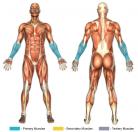Behind-the-Back Wrist Curls (Barbell)
- Standing upright, grasp the barbell behind you body at shoulder width apart, your palms should face backwards, and your arms should hang fully extended.
- Acquire a firm grip on the bar and remove it from its stand.
- Using your wrists alone, reverse-curl the weight upward, exhaling throughout the movement.
- Slowly lower the weight as low as is comfortable (for fear of the weight slipping from one's fingers), inhaling throughout the movement.
- Repeat steps 3-4.
Once you have gripped the bar appropriately, if you are an advance lifter you may choose to use the following method:
- Starting with a full grip on the bar, let the bar roll from your palm to your fingers and close/hook your finger tips around the bar once the bar reaches the bottom, inhaling throughout the movement.
- Curl the weight upward by tightening the fingers and lift the weight back into the palms, bend the wrists upward (further yet) once a full grip is assumed so that they are as near to parallel with the ground as is possible, exhaling throughout the movement.
- Your forearms will be fully flexed and you can now repeat the exercise from this position.
This exercise is meant to be a power lift, in as much as one can power lift by doing a forearm focused exercise, so each repetition should take less than a second.
While this exercise may seem fairly complex, it actually quite simple to perform once the basic concept is grasped. It is recommended to start off with a low weight to ascertain the correct weight for the exercise. Due to the upright position in which this exercise is performed, the hand and finger tendons and ligaments receive additional strain. Be sure to factor this in when deciding the appropriate weight to lift for this exercise. Note, also, that although the movement of this exercise is slight, the difficultly and burn can be substantial. This is normal.
Although dumbbells can be used to perform this exercise, it is recommended that they are not used because they are awkward and can make the wrists more susceptible to injury. This exercise is more effective with the use of a barbell.
There are some professionals that recommend either allowing the weight to leave the thumb's grasp at the end/bottom of the movement or using a false grip (a description for "false grip" is in the next paragraph) to get the most out of this movement. Unless you have extremely powerful forearms or are an advanced lifter, you will get plenty from this exercise by simply curling the weight upward and letting it down, all the while keeping a rather firm grip on the weight.
A false grip is a grip where the thumbs are not wrapped around the bar. However, a potential consequence of using this grip could be injury. If the hands are sweaty or form falters the weight may fall at the peril of you or others.





